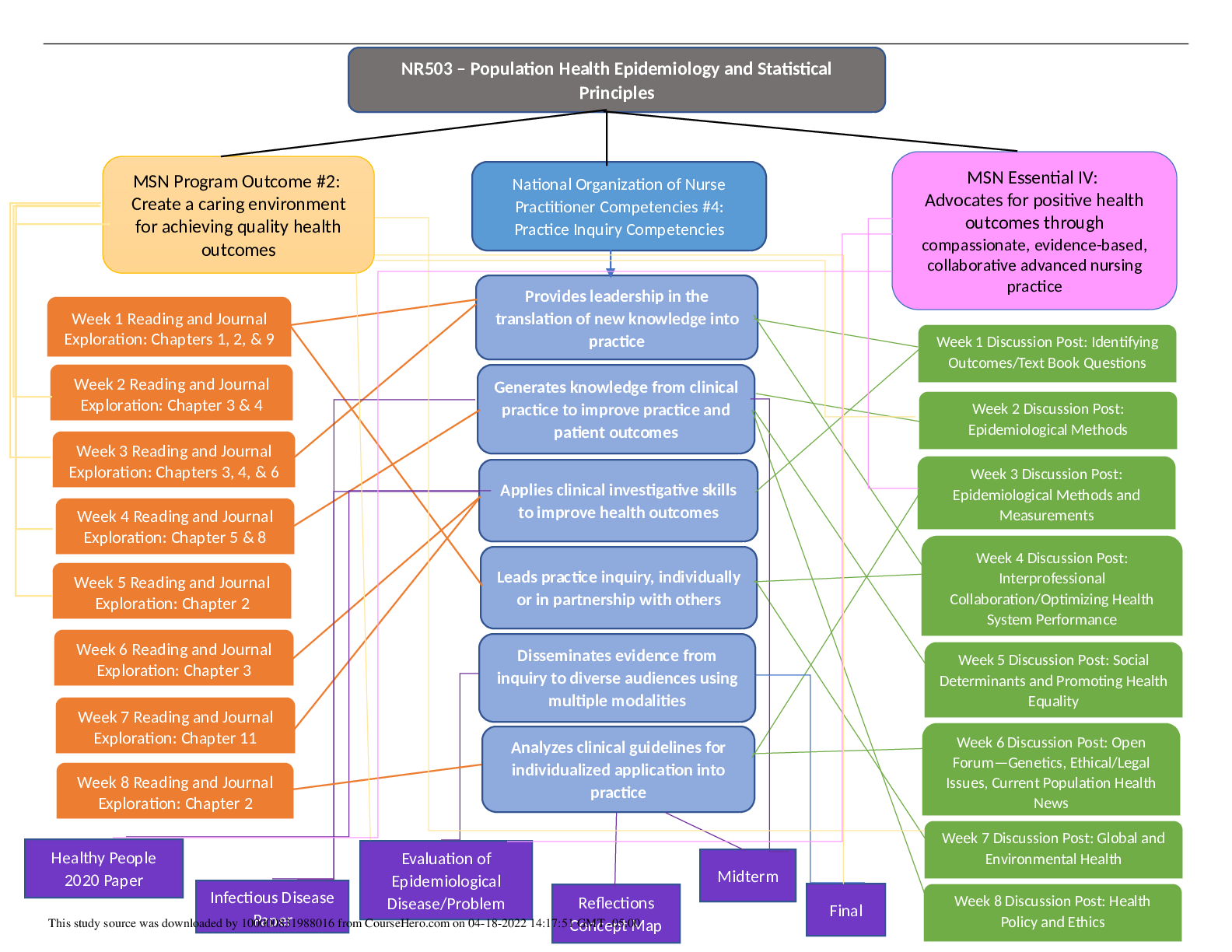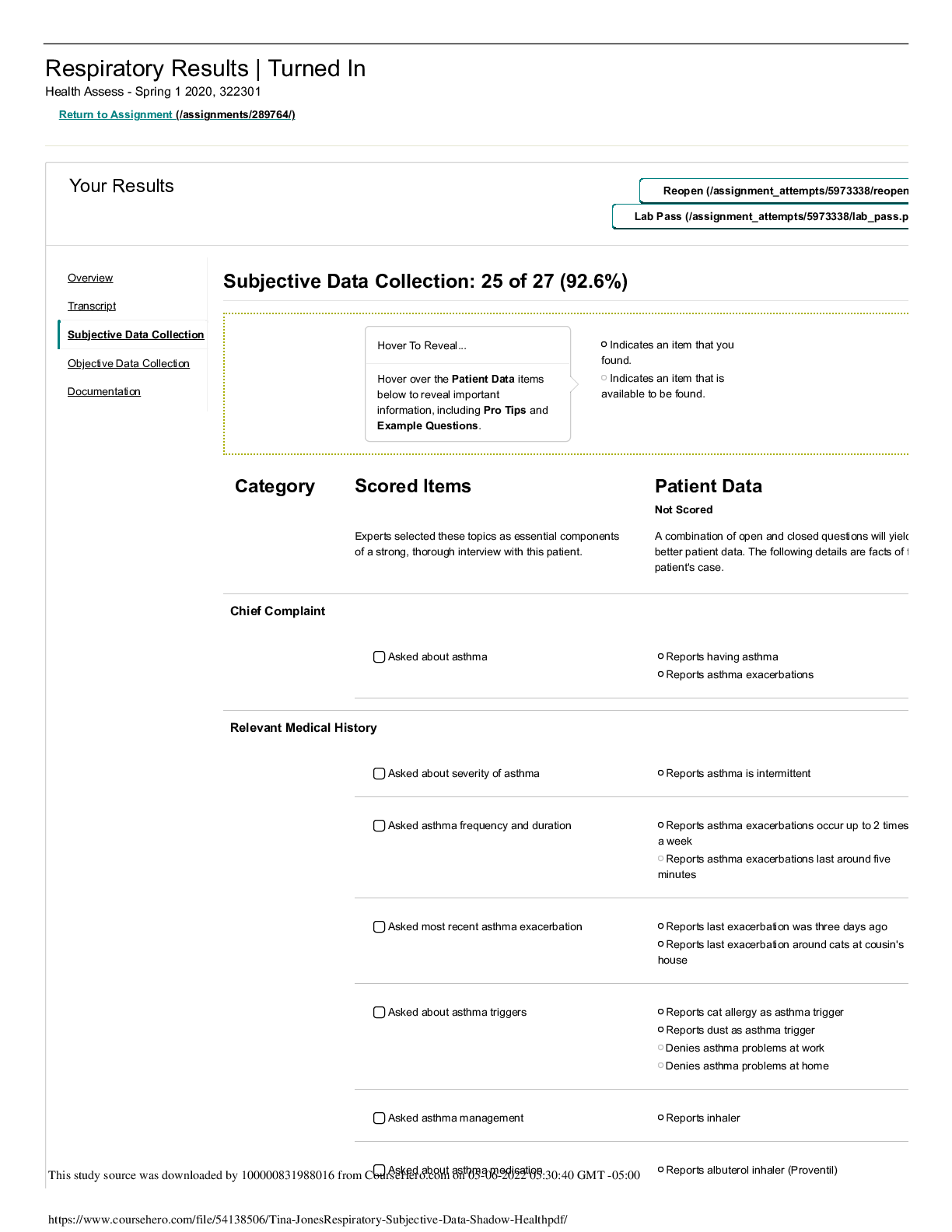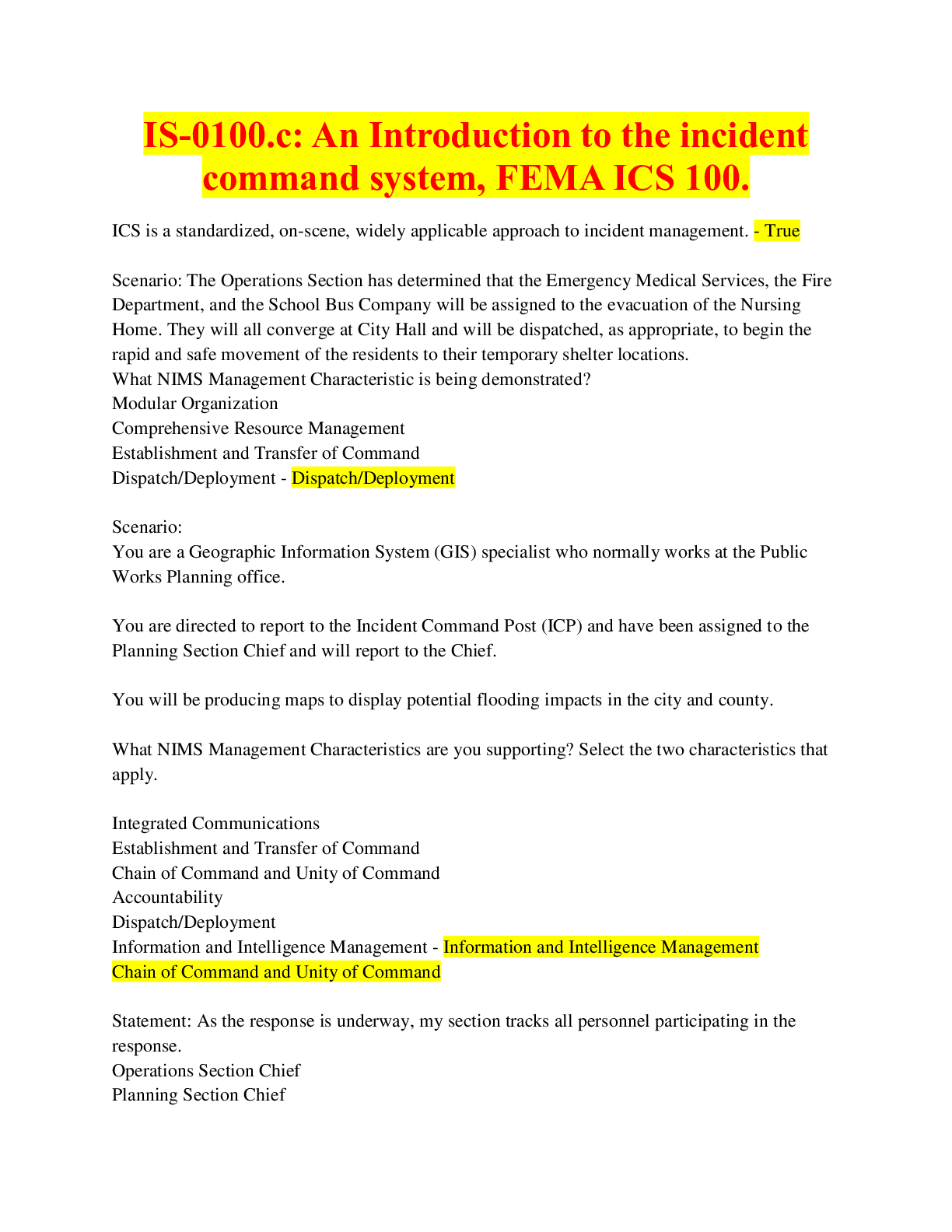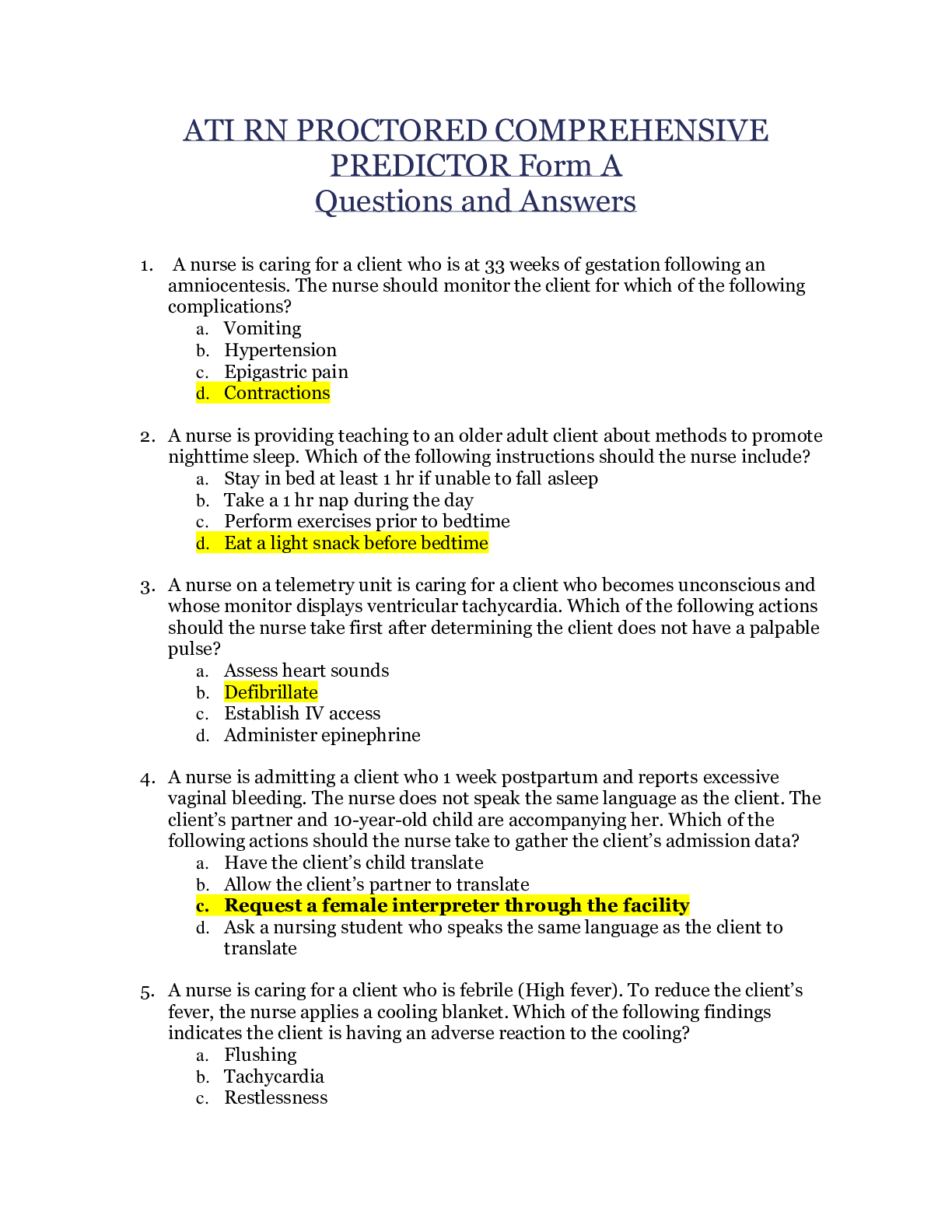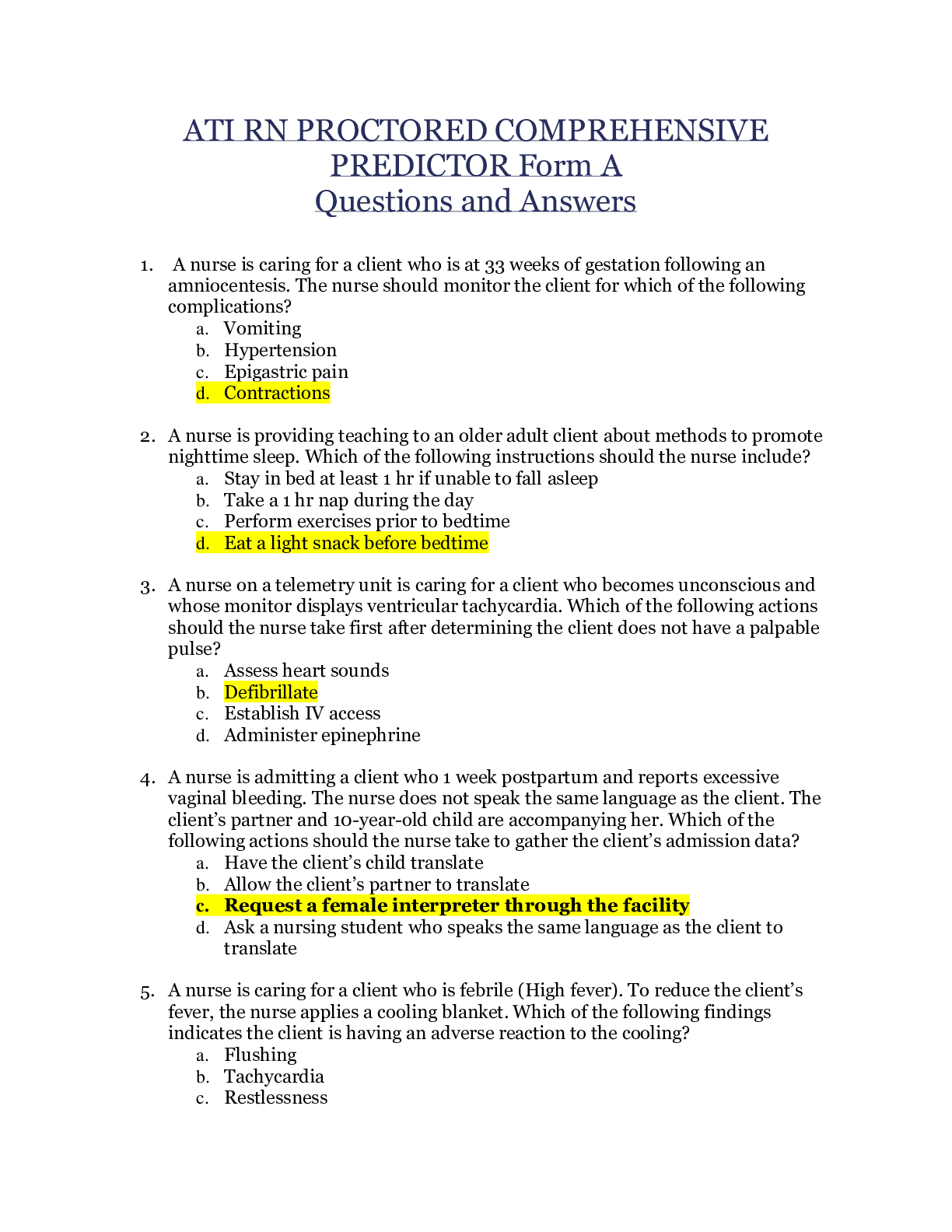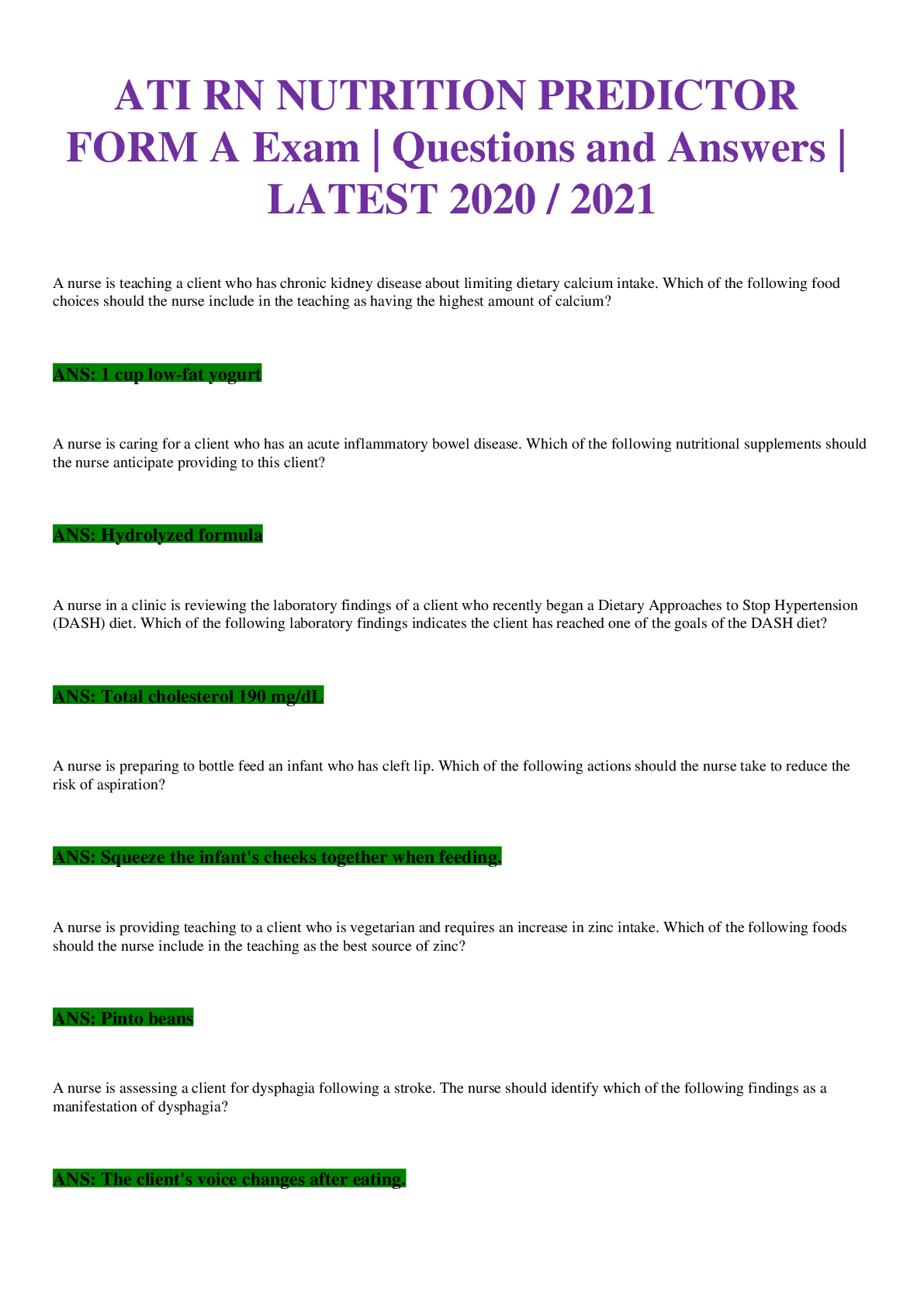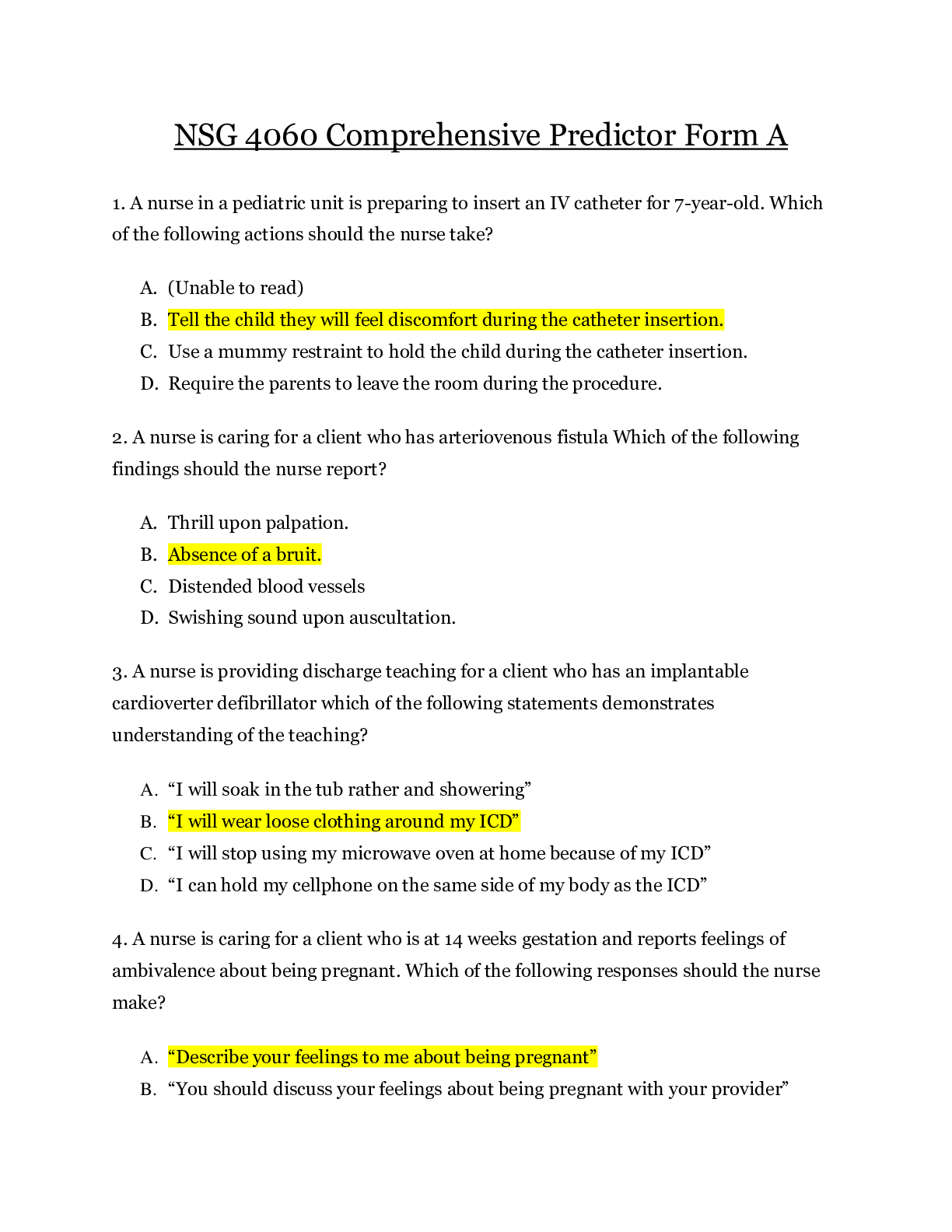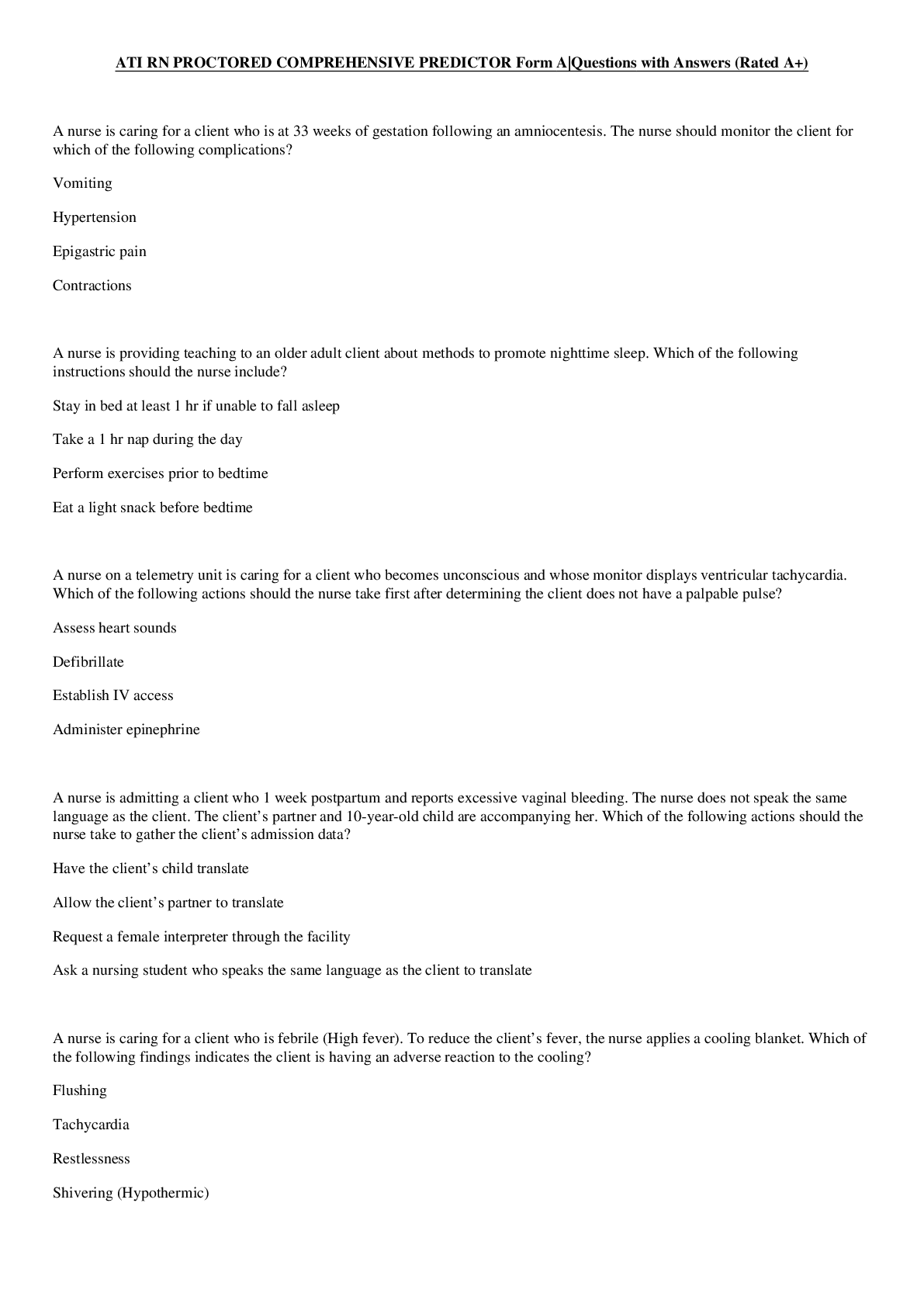RN Comprehensive Predictor Form A (A+ GUIDE)
Document Content and Description Below
RN Comprehensive Predictor Form A (A+ GUIDE)/RN Comprehensive Predictor 2019 Form A 1. A nurse in a pediatric unit is preparing to insert an IV catheter for 7-yearold. Which of the following actions... should the nurse take? A. (Unable to read) B. Tell the child they will feel discomfort during the catheter insertion. C. Use a mummy restraint to hold the child during the catheter insertion. D. Require the parents to leave the room during the procedure. 2. A nurse is caring for a client who has arteriovenous fistula Which of the following findings should the nurse report? A. Thrill upon palpation. B. Absence of a bruit. C. Distended blood vessels D. Swishing sound upon auscultation. 3. A nurse is providing discharge teaching for a client who has an implantable cardioverter defibrillator which of the following statements demonstrates understanding of the teaching? A. “I will soak in the tub rather and showering” B. “I will wear loose clothing around my ICD” C. “I will stop using my microwave oven at home because of my ICD” D. “I can hold my cellphone on the same side of my body as the ICD” 4. A nurse is caring for a client who is at 14 weeks gestation and reports feelings of ambivalence about being pregnant. Which of the following responses should the nurse make? A. “Describe your feelings to me about being pregnant” B. “You should discuss your feelings about being pregnant with your provider” C. “Have you discussed these feelings with your partner?” D. “When did you start having these feelings?” 5. A nurse is planning care for a client who has a prescription for a bowel- training program following a spinal cord injury. Which of the following actions should the nurse include in the plan of care? A. Encourage a maximum fluid intake of 1,500 ml per day. B. Increase the amount of refined grains in the client’s diet. C. Provide the client with a cold drink prior to defecation. Administer a rectal suppository 30 minutes prior to scheduled defecation times. D. 6. A nurse is caring for a client who is in active labor and requests pain management. Which of the following actions should the nurse take? A. Administer ondansetron. B. Place the client in a warm shower. C. Apply fundal pressure during contractions. D. Assist the client to a supine position. 7. a nurse in an emergency department is performing triage for multiple clients following a disaster in the community. To which of the following types of injuries should the nurse assign the highest priority? A. Below-the knee amputation B. Fractured tibia C. 95% full-thickness body burn D. 10cm (4in) laceration to the forearm 8. a nurse manager is updating protocols for the use of belt restraints. Whichof the following guidelines should the nurse include? A. Remove the client’s restraint every 4hr B. Document the client’s condition every 15 min C. Attach the restrain to the bed’s side rails D. Request a PRN restrain prescription for clients who are aggressive 9. A nurse is teaching an in-service about nursing leadership. Which of the following information should the nurse include about an effective leader? A. Acts as an advocate for the nursing unit. B. (Unable to read) for the unit C. Priorities staff request over client needs. D. Provides routine client care and documentation. 10. A nurse is reviewing the laboratory findings of a client who has diabetes mellitus and reports that she has been following her (unable to read) care. The nurse should identify which of the following findings indicates a need to revise the client’s plan of care. A. Serum sodium 144 mEq/ B. (Unable to read) C. Hba1c 10 % D. Random serum glucose 190 mg/dl. 11. A nurse in a provider’s office is reviewing the laboratory results of a group of clients. The nurse should identify that which of the following sexually transmitted infections is a nationally notifiable infectious disease that should be reported to the state health department? A. Chlamydia B. Human papillomavirus C. Candidiasis D. Herps simplex virus 12. A nurse is teaching a newly licensed nurse about therapeutic techniques to use when leading a group on a mental health unit. Which of the following group facilitation techniques should the nurse include in the teaching? A. Share personal opinions to help influence the group’s values B. Measure the accomplishments of the group against a previous group C. Yield in situations of conflicts to maintain group harmony D. Use modeling to help the clients improve their interpersonal skills 13. A nurse is planning for a client who practices Orthodox Judaism. The client tells the nurse that (Unable to read) Passover holiday. Which of the following action should the nurse include in the plan of care? A. Provide chicken with cream sauce. B. Avoid serving fish with fins and scales. C. Provide unleavened bread. D. Avoid serving foods containing lamb. 14. A nurse is caring for a client who has a pulmonary embolism. The nurse should identify the effectiveness of the treatment A. A chest x-ray reveals increased density in all fields. B. The client reports feeling less anxious. C. Diminished breath sounds are auscultated bilaterally D. ABG results include Ph 7.48 PaO2 77 mm Hg and PaCO2 47 mm Hg. 15. A nurse in an emergency department is assessing a client who reports ingesting thirty diazepam tablets (Unable to read) a respiratory rate of 10/min. After securing the client’s airway and initiating an IV, which of the following actions should the nurse do next. A. Monitor the client’s IV site for thrombophlebitis. B. Administer flumazenil to the client. C. Evaluate the client for further suicidal behavior. D. Initiate seizure precautions for the client. 16. A nurse in an emergency department is caring for a client who reports cocaine use 1hr ago. Which of the following findings should the nurse expect? A. Hypotension B. Memory loss C. Slurred speech D. Elevated temperature 17. A nurse is assessing a newborn who has a blood glucose level of 30 mg/dl. Which of the following manifestations should the nurse expect? A. Loose stools B. Jitteriness C. Hypertonia D. Abdominal distention 18. A nurse in a pediatric clinic is reviewing the laboratory test results of a school age child. Which of the following findings should the nurse report to the provider? A. Hgb 12.5 g/dl B. Platelets 250,000/mm3 C. Hct 40% D. WBC 14,000/mm3 19. A charge nurse is teaching a newly licensed nurse about clients designating a health care proxy in situations that require a durable power of attorney for heal care (DPSHC). Which of the following information should the charge nurse include? A. “The proxy should make health care decisions for the client regardless of the client’s ability to do so.” B. “The proxy can make financial decisions if the need arises.” C. “The proxy can make treatment decisions if the client is under anesthesia.” D. “The proxy should manage legal issues for the client.” 20. A nurse in the PACU is caring for a client who reports nausea. Which of the following actions should the nurse take first? A. Turn the client on their side. B. Administer an analgesic C. Administer antiemetic D. Monitor the client’s vital signs. 21. A nurse is caring for a client who has a history of depression and is experiencing a situational crisis. Which of the following actions should the nurse take first? A. Confirm the client’s perception of the event B. Notify the client’s support system C. Help the client identify personal strengths D. Teach the client relaxation techniques 22. A nurse is caring for a client who has bipolar disorder and is experiencingacute mania. The nurse obtained a verbal prescription for restraints. Which of the following should the actions should the nurse take? A. Request a renewal of the prescription every 8 hr. B. Check the client’s peripheral pulse rate every 30 min C. Obtain a prescription for restraint within 4 hr. D. Document the client’s condition every 15 minutes. 23. A 24. A charge nurse on a medical-surgical unit is planning assignments for a licensed practical nurse (LPN) who has been sent from the (Unable to read) unit due to a staffing shortage. Which of the following client should the nurse delegate to the LPN? A. A client who has an Hgb of 6.3 g/dl and a prescription for packed RBCs. B. A client who sustained a concussion and has unequal pupils. A client who is postoperative following a bowel resection with an NG tube set to continuous suction. C. D. A client who fractured his femur yesterday and is experiencing shortness of breath. 25. A nurse is working on a surgical unit is developing a care plan for a client who has paraplegia. The client has an area of nonblanchable erythema over his ischium. Which of the following interventions should the nurse include in the care plan? A. Place the client upright on a donut-shaped cushion B. Teach the client to shift his weight every 15 min while sitting C. Turn and reposition the client every 3 hr while in bed D. Assess pressure points every 24 hr 25. A nurse is caring for a client who is dilated to 10 cm and pushing. Which of the following pain-management (Unable to read) a safe option for the client? A. Naloxone hydrochloride. B. Spinal anesthesia. C. Pudendal block. D. Butorphanol tartrate. 26. C 27. A nurse is assessing a client who has major depressive disorder. Which ofthe following findings should the nurse identify as the (Unable to read) (Most important?) A. The client changes the subject when future plans are mentioned. B. The client talks about being in pain constantly. C. The client sleeping over 12 hr. each day. D. The client reports giving away personal items. 28. A nurse is providing teaching about immunizations to a client who is pregnant. The nurse should inform the client that she can receive which of the following immunizations during pregnancy? (Select all that apply) A. Varicella vaccine. B. Inactivated polio vaccine. C. Tetanus diphtheria and acellular pertussis vaccine D. Rubella vaccine. E. Inactivated influenza vaccine. 29. A nurse is caring for a client who has end-stage kidney disease. The client’s adult child asks the nurse about becoming a living kidney donor for her father. Which of the following condition in the child’s medical history should the nurse identify as a contraindication to the procedure? [Show More]
Last updated: 3 years ago
Preview 1 out of 42 pages
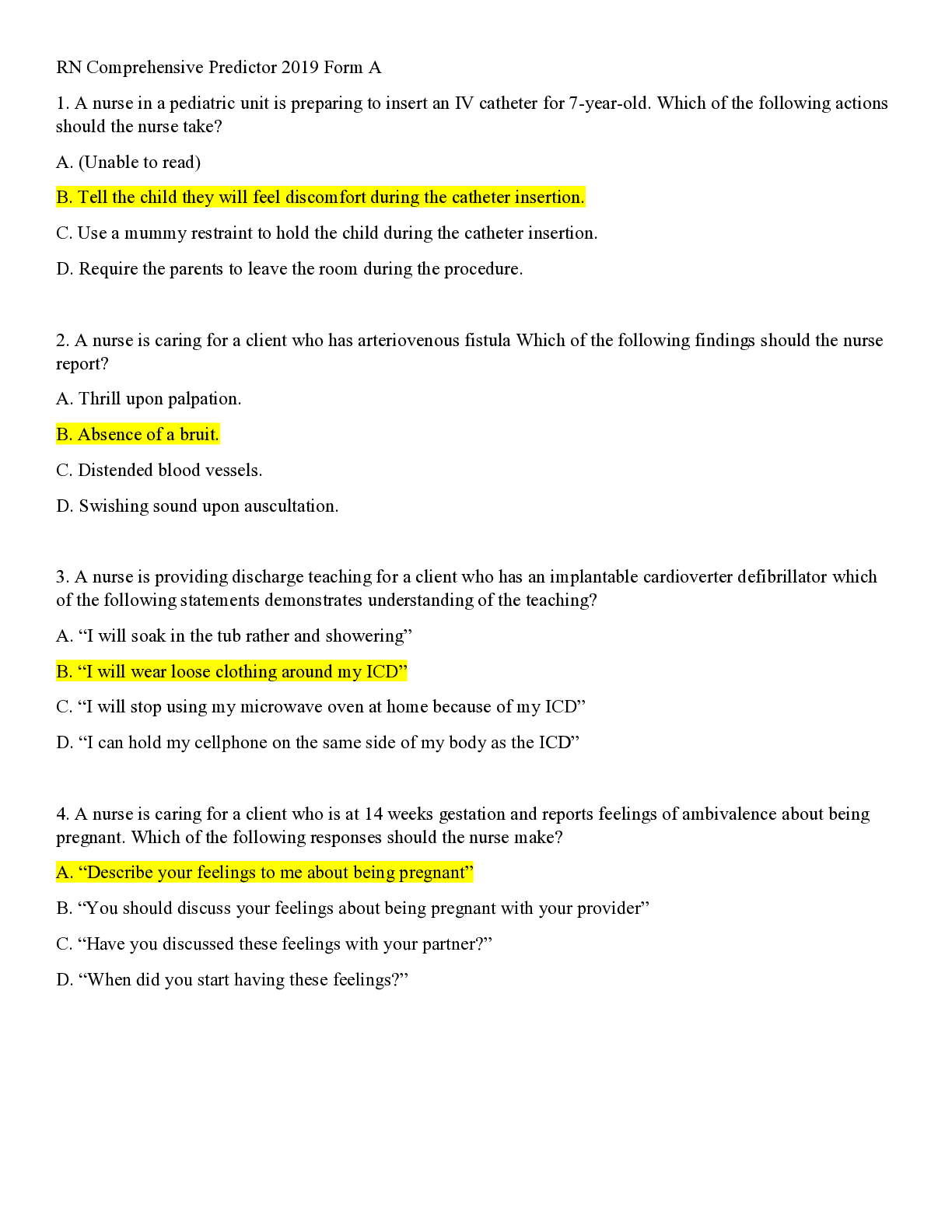
Buy this document to get the full access instantly
Instant Download Access after purchase
Add to cartInstant download
We Accept:

Also available in bundle (2)

LATEST UPDATED BUNDLE FOR AA RN Comprehensive Predictor 2019 FORM A,B & C QUESTIONS (LATEST VERSION ) WITH ALL COMPLETE UPDATED SOLUTIONS (A+ GUIDE) DOWNLOAD TO SCORE AN A (VARIOUS VERSIONS)
LATEST UPDATED BUNDLE FOR AA RN Comprehensive Predictor 2019 FORM A,B & C QUESTIONS (LATEST VERSION ) WITH ALL COMPLETE UPDATED SOLUTIONS (A+ GUIDE) DOWNLOAD TO SCORE AN A (VARIOUS VERSIONS)
By PROF 3 years ago
$22.5
7

ATI/ATI RN Comprehensive Predictor Exams and Study Guide PACKAGE A+ Guide
ATI/ATI RN Comprehensive Predictor Exams and Study Guide PACKAGE A+ Guide
By PROF 3 years ago
$50
4
Reviews( 0 )
$14.50
Document information
Connected school, study & course
About the document
Uploaded On
Mar 30, 2021
Number of pages
42
Written in
Additional information
This document has been written for:
Uploaded
Mar 30, 2021
Downloads
0
Views
58






